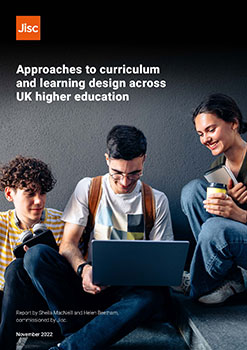Approaches to curriculum and learning design across UK higher education
Looking beyond the emergency responses to lockdowns and restrictions - are we delivering learning in flexible and accessible ways?

This report contains:
- A review of current literature and research into blended learning and models of practice
- A survey of the higher education (HE) sector on current practice/challenges around developing degree courses
- A series of interviews with a range of educational practitioners
- Recommendations identifying areas where Jisc could develop resources, guidance and effective partnership approaches
Key findings
- Teaching and learning strategies are the main drivers for the curriculum design process in organisations
- Since the pandemic, there is evidence of major curriculum reviews and new interest in modes of delivery
- Learning design resources may be a route to encouraging open educational practice
- There are clear links between quality assurance, quality enhancement and staff engagement with learning design
- A strategic approach is needed for consistency in curriculum design and support
- Staff workload allocation, staff reward structures and investment in academic staff development were key concerns
- Engaging students as co-creators in curriculum and learning design is more of an aspiration than a realisation for many
Download an executive briefing for senior leaders in higher education (pdf).
Full report
pdf, 7.1 MB, 40 pages
Examples of practice from the sector
- The University of Hull launched a new competency-based curriculum framework replacing learning outcomes with programme-level, discipline-specific competencies
- As part of its digital transformation strategy, Teesside University has been rolling out a series of design bootcamps to produce an action plan
- At the University of Northampton, a learning designer is on review panels, and the university has incorporated quality standards into its workshops/support
- Based on the pandemic experience, UCL is keeping assessments online with a new team of digital assessment advisors to support academics and develop the assessment system
- The Open University is exploring ways to use more qualitative data representing the student voice, alongside their quantitative data
Challenges for universities moving forward
To meet the challenges of flexibility around space, place and modes of delivery, universities should consider providing updated workload models. These need to recognise (and reward) the changing needs for staff to engage with design activities, evaluate their practice and provide support for innovation to engage learners.
There is a need for a shared vocabulary and understanding around modes of participation. Evidence of different student experiences and outcomes could be shared across the sector, along with examples of different ways of organising time, space, and independent and collaborative working.
“Managing any support initiatives will be tough. With limited resources ‘teaching to the middle’ is common. The gap between eager/advanced online tutors, those in the middle and those who are lagging behind has grown and that will have to be addressed.” — Survey participant
Next steps
Find out how Jisc can support you with digital tools and mechanisms to enrich the learning and teaching experience for your students on campus and in the work place. You can also read our beyond blended report on post pandemic curriculum design.
About the authors

